Chapter Nine: Vehicles
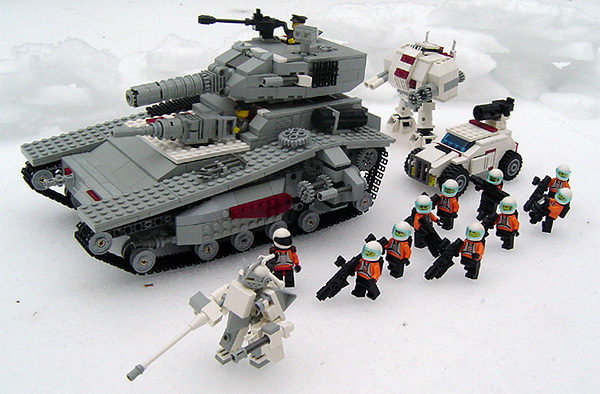
| An Assyrian detachment treks across the frozen wastelands of the Iceworld Krysto. |
Photo: Natalya
from "2011 Snowpocalypse"
Elements shown: LEGO |
|
Heavy weapons are all about location; they're only as valuable as the targets they can reach. Sadly, it's rare to find an opponent considerate enough to build targets next to your weapons, or who will allow you to build weapons next to their targets.
Rather than limiting weapons to the targets supplied by a single location, it's handy to give them a means of moving around. The value of a fine weapon can be increased dramatically by strapping a Vehicle to it.
9.1: Standard Propulsion
 Creations that move around are called Vehicles, and every
Vehicle requires at least one Propulsion system, even
if the method of powering that Propulsion is hard to explain. (Construction-brick
siege engines are notorious for rolling around merrily
despite a lack of horses or slaves to pull them.) Creations that move around are called Vehicles, and every
Vehicle requires at least one Propulsion system, even
if the method of powering that Propulsion is hard to explain. (Construction-brick
siege engines are notorious for rolling around merrily
despite a lack of horses or slaves to pull them.)
For game purposes, all that’s
important is the Vehicle's type of movement. Whether or not it has
any means to power that movement is politely overlooked.
Like all devices in BrikWars, every Propulsion system should be represented by specific physical elements. Most will be obvious: wheels and sails and zeppelin balloons are represented by wheel elements and sail elements and zeppelin balloon elements, respectively. For more esoteric Propulsion systems, like the series of levitation crystals that use sparkle power to transport a floating bordello from one war camp to the next, the physical components should be pointed out to the other players so there's no confusion about which elements to target first.
Propulsion Types
| Propulsion Types |
| Type |
Cost |
Examples |
| Standard Propulsion |
1CP per 2" Move |
wheels, legs, oars, treads |
| Flight Propulsion |
(2CP + Structure Level) per 2" Move |
dragon wings, antigravity, capes |
| Forward Flight Propulsion |
(1CP + Structure Level) per 2" Move |
plane wings, bird wings |
|
Most regular types of Propulsion (Ground, Water, and Underwater) cost 1CP per two
inches of Move (e.g., it costs 5CP to buy 10” of Ground movement). Flying is more expensive:
every two inches of Move cost 2CP plus
the creation’s Structure Level (for instance, an armored space
transport with Structure Level 2 would pay
4CP for each 2" of Hover Flight movement). Forward Flying Vehicles that need to maintain a minimum forward sped to stay aloft (like gliders, biplanes, or ducks) are slightly cheaper, costing 1CP plus
the creation’s Structure Level for every two inches of Move.
More unusual Propulsion types (spider climbing, underground
tunneling, teleportation) may be allowed as well, if the players can
come to mutual agreement about appropriate rules and CP costs.
| Movement Speed Examples |
| Move" |
Creatures |
Ground Vehicles
default: 10" |
Water Vehicles
default: 8" |
Flying Vehicles
default: 12" |
| 3" |
spiders, scorpions, zombies |
wheelchairs, catapults |
rowboats, rafts |
hot air balloons |
| 5" |
minifigs, monkeys, octopi |
bulldozers, lawnmowers, golf carts |
galleys, steamboats |
zeppelins |
| 8" |
dogs, alligators, elephants, sharks |
bicycles |
galleons, submarines |
gliders, minicopters |
| 10" |
horses, lions |
tanks, trains |
clippers |
assault helicopters |
| 12" |
birds, flying dragons |
cars |
motorboats |
helicopters, light aircraft |
| 16" |
superheroes |
sports cars, motorcycles |
speedboats |
fighter planes, spacecraft |
| (upper limit for
regular propulsion types) |
| 20" |
flying superheroes |
- |
- |
fighter jets, starfighters |
| (upper limit for
flight propulsion) |
|
Players choose the Move rating of their Propulsion system according to what they feel is appropriate. Example Move ratings are given above.
Alternate Movement
Vehicles may sometimes move outside of their usual medium if it’s
appropriate to do so. Common sense should be an adequate guide: automobiles
can move at lower speed through standing water, but they can’t
fly; airplanes can move at lower speed on the runway, but can’t
swim; submarines may move at lower speed on the ocean surface, but
can’t start rolling around on land.
Vehicles moving in an alternate medium move at Half Speed (4.1: Movement). No matter
how much Move they have to spend, no Vehicle can move more than
five inches in an alternate medium in any single turn.
Sprinting
Like minifigs, a Vehicle can be made to Sprint (4.1: Movement) in order to add its Operator's Skill Roll to its Move inches, as long as it's driving in a straight line. As with any other unit, Vehicles can't make any turns at all while Sprinting.
Propulsion Damage
| Propulsion Damage |
| Damage |
Effect |
| Major Propulsion Element Lost |
-1" Move, cumulative |
Half of Propulsion Elements Lost /
Vehicle Dragging on Ground |
Half Speed |
| All Propulsion Elements Lost |
Move eliminated |
| Critical Flight Element Lost |
Flying Move eliminated |
| Forward Flight Reduced to Half Speed |
Forward Flying Move eliminated |
|
For most devices, Damage is an all-or-nothing affair. A steering wheel
is either slagged or it isn't; an elbow is either still attached
or it's not.
Propulsion systems are a little more granular. If attackers
can destroy or disable a major propulsion component (one tire off
a dune buggy, one leg off of a RoboSpider), the vehicle's Move is
reduced by 1" for each lost component. If half of the propulsion
elements are destroyed (one leg off a Tyrannosaurus, one wheel off
a motorcycle), or if any part of the Vehicle is dragging on the ground, then the Vehicle moves at Half Speed, after applying all other applicable penalties.
If all the elements are destroyed (one pogo off of a pogo stick, one
balloon off of a balloon), the Vehicle's ability to Move is eliminated
entirely.
Aerodynamic Flight systems are especially fragile (as opposed to space or magic Flight, which tend to be more resilient). The destruction
of one blade of a helicopter or one wing of a dragon is enough to
ground them immediately.
Vehicles Flying above the ground need a minimum amount of Propulsion strength to stay in the air. (Vehicles Flying in orbit or in space have no such problems). Any time a Flying Vehicle is reduced to Half Speed for any reason, it falls out of the sky at the end of the turn. Any time a Forward Flight Vehicle moves forward a real distance of half its maximum Move inches or less, whether due to penalties from Size Damage, Propulsion Damage, or even simple encumbrance, it will also fall out of the sky at the end of the turn.
Loss of Control
A Vehicle can lose control for any number of reasons. The operator might be dead, absent, or distracted by text messages. Controls might be disconnected, destroyed, or contradicted by auxiliary Controls. Propulsion systems might be damaged, disabled, or sabotaged to function perfectly but in the wrong direction.
Out-of-Control Vehicles keep going in whichever direction they were already going, at whatever speed they were already moving. Their movement continues in a straight line every turn until they Crash into something (9.5: Collisions) or exit the battlefield, unless players come up with a specific reason they should change direction.
A Vehicle that loses power (the fuel line is severed, the minifig working the pedals implodes, etc) or loses Propulsion effectiveness (a truck tipped off its wheels, a boat beaching itself) can use its remaining Momentum (if any) to continue moving on the following turn, buying one Skill die of Move inches (or one d4 of inches, if the vehicle lacks a Skilled operator) for each MOM spent. It then grinds to a halt. Flying Vehicles, in particular, grind to a halt by nosediving straight down from their final position and smashing into the ground.
9.2: Standard Maneuvering
Minifigs and animals are used to unlimited maneuvering. Minifigs are free to spend their Move inches almost however they want - running, climbing, spinning, jumping, hopping sideways, and rolling around at will.
Most Vehicles aren't able to move quite this freely, and are subject to maneuvering restrictions.
Like minifigs, a Vehicle can be made to Sprint (4.1: Movement) in order to exceed its normal Move limit in a straight line. As with any other unit, Vehicles cannot make any turns at all while Sprinting.
Forward Maneuvering
Biplanes, monster trucks, and surfboards aren't able to spin in place or hop sideways the way minifigs can, and when they do, it usually means something's gone wrong. By default, all Vehicles depend on Forward Maneuvering - they must be moving forwards or backwards in order to turn.
In almost all cases, players' instincts about their own Vehicles' maneuverability are good enough. Players tend to have a pretty good idea of what kind of maneuvers a tricycle can and can't perform as compared to a mechadragon or a hot air balloon. Forward Maneuvering rules should only be used in isolated instances when players want a large Vehicle to feel ponderous, or on a temporary basis when they decide that a Vehicle enters a maneuvering space that's tight enough that the limits will make a real difference.
The minimum turning radius for a Forward Maneuvering Vehicle is determined by the length of its main Structure (7.1: Structure). For a Forward Maneuvering Vehicle, any turns are legal as long as it clears the length of its own Structure between ninety-degree turns.
| Some Vehicles, like naval vessels and siege engines, may be so large or so slow that it takes multiple turns for them to travel their own Structure length. For Vehicles like these, it's better to use their Move as inches of Pull Thrust rather than Forward Maneuvering (9.3: Thrust Vectors). |
Apart from Forward Flight Vehicles, almost all Forward Maneuvering Vehicles can move backwards, but they do so at Half Speed.
Stationary Maneuvering
Certain types of propulsion systems have the ability to Turn in Place while stationary. Rowboats, hovercraft, helicopters, antigravity spacefighters, and Vehicles on treads or legs all have the ability to turn and face a new direction without the need to move forwards or backwards. This is entirely up to the common sense of the players and doesn't have any extra CP cost.
A Stationary Maneuvering Vehicle may use its Move inches for Forward Maneuvering as usual, but it may also use inches to Turn in Place at any point during regular movement. Find the point on the Vehicle's Structure furthest away from the center of rotation, and rotate that point as many Move inches as necessary for the Vehicle to Turn In Place.
Flight Maneuvering
When Flying Vehicles use Forward Maneuvering, they are limited to forty-five degrees per turn, including any pitch change. Except in outer space, a Flying Vehicle may never raise its pitch to more than forty-five degrees above the horizontal, although it can point as inadvisably far downward as it likes. If you aren't keeping track of Flying Vehicles' specific altitudes, consider them all to be five inches off the ground by default.
Flying Vehicles may drop bombs or other objects from any height, but for all other weapon types they must be no more than five vertical inches higher than a target in order to attack it.
When dropping bombs or other objects, Flying Vehicles may only target spots directly underneath their own flight path. Like other ranged attacks, the dropped object may end up off of that path due to a Missed Shot (5.3: Ranged Combat). The Use rating for aiming dropped objects is equal to either the object's Size or the distance of the drop in inches, whichever is greater.
| When dropping Explosives, remember that the Use rating is based on the object's physical Size rather than its Explosive Size. Because Explosive Size is determined by bricks rather than inches (8.1: Weapon Size), a Size 3 Explosive might only be a Size 1" object for dropping purposes. |
Unlimited Maneuvering
While uncommon, there are a few types of Propulsion systems that can match a minifig's freedom of mobility. If a Vehicle's Propulsion system is based on sufficiently agile limbs (mecha, horses, robot velociraptors, minifigs) or hover flight (helicopters, flying carpets, flying saucers), then that Vehicle is Maneuverable and it has the potential to prance around as freely as any minifig.
In order to take advantage of its Maneuverability, the Vehicle must be controlled by an operator with the Piloting (9.4: Piloting) or Horsemanship Specialty. A Maneuverable Vehicle that's controlled by operators without these Specialties are limited to regular Forward and Stationary Maneuvering instead; full Maneuverability is too complicated for untrained minifigs to handle effectively.
Jumps
Vehicles with legs (or some other jumping system) can leap across any distance within their Move radius, although the height of the leap can't exceed twice the height of their legs (or other jumping system).
Vehicles on wheels or the equivalent can only Jump by building up Momentum (9.5: Collisions) and launching themselves off of ramps.
When a
Vehicle is launched off a ramp, it continues traveling in a straight line in the direction at which it left the ramp. The distance of the Jump is determined by the Vehicle's Momentum - each MOM spent adds one Skill die of Jump distance.
The Vehicle can continue flying in a straight line for any distance up to the limit of its Move inches, and then drops straight down to end its Movement for the turn. Depending on the height of the drop at the end, a Jumping Vehicle may take Collision Damage with the ground when it lands (9.5: Collisions).
| Non-Flying Vehicles generally have no ability to turn while in midair, but What I Say Goes exceptions might be made for Vehicles equipped with some kind of sails or airfoils. |
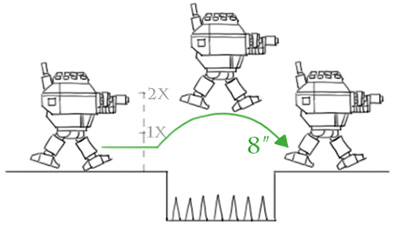
A Dreadnut can jump up to twice the height of its own legs in order to clear this inconvenient spike pit.
|
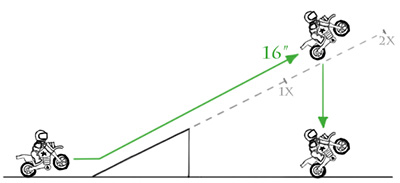
Thanks to some unexpected Bonus Dice, this stuntbike is able to convert its two MOMs into 16" of Jump distance. This gives the bike enough altitude to cause Collision Damage from the height of the drop. |
9.3: Thrust Vectors
| Thrust Device |
| Device |
Cost |
Effect |
Notes |
| Thruster |
(Size x2) CP |
(Size x5") Thrust |
Uses (Size) Power |
|
In addition to the standard Propulsion system, BrikWars allows for Vehicles and objects that are moved by physically pushing or pulling the model with specific Thrust forces. For Vehicles, directed Thrust can be provided by Thrusters like rockets, jet engines, propellers, or sails. Thrust is also the system used to handle the KnockBack from Shoves, Collisions, attacks, and weapon recoil, or from unusual devices like tractor beams and gravity guns.
Each Thrust effect has two parts: a direction and a number of inches. (The inches are always a whole number; fractional inches are rounded down.)
The Finger
| “God does not care about our mathematical difficulties. He integrates empirically.” |
| - Albert Einstein |
As any mathematician will tell you, vector algebra is an infinitely bigger pain in the ass than either vectors or algebra would seem to indicate on their own. Worse, vector algebra becomes increasingly difficult to perform after a fourth shot of whiskey, making it useless for any part of BrikWars after the first three minutes.
Fortunately, a BrikWars player's instinctive response to Thrust vector calculations turns out to be the correct one: Thrust is handled by Giving It The Finger. Place a fingertip at the point of Thrust (either an active Thruster or a point of impact, usually), and push the object the appropriate number of inches in the appropriate direction. The model on the table will move and rotate appropriately on its own without any need for calculation. (Wheeled models may need to be stopped manually at the end of each Thrust to keep them from rolling away forever.)
KnockBack from Shoves, Collisions, large Weapon strikes, and Explosions are all executed neatly and efficiently by Giving Them the Finger.
If the object is using Thrust as part of its own Movement, then it can apply Thrust before, after, or during whatever other maneuvers it makes during its turn.
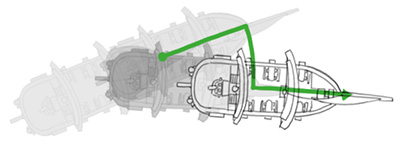
As part of its regular Movement, this sailing ship receives several inches of forward Thrust from its square sails, and additional inches of thrust to starboard from the staysail. The player decides to use half of the forward Thrust, then push the front of the ship to starboard with the staysail's Thrust, and then finish with what remains of the forward Thrust.
When using Thrust with sailing vessels, it's better to pull from the front rather than push from the rear - this better simulates the drag of ocean water on the vessel. |
|
For an object affected by multiple points of Thrust at the same time, the player controlling the object (if any) may Give those Thrusts the Finger in whichever order he prefers, or split individual Thrusts into smaller Thrusts for fine maneuvering, or even Finger multiple Thrusts at the same time if it seems appropriate. Giving the Finger to Thrusts is not a precise science, and will often involve quite a bit of Fudge.
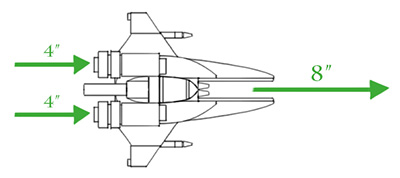
| Parallel Thrust inches from this fighter's twin thrusters can be Fudged into a single combined forward Thrust. Similarly, Thrust inches from opposite directions on an object can be Fudged to cancel each other out completely. |
|
In the worst-case scenario, rather than resolving Thrust effects one at a time, a player may wish to determine the cumulative result of many simultaneous Thrusts and only then move the object from its initial position to its final one. This is a legal and sometimes even necessary option, but it's a pain in the ass and should be avoided.
9.4: Piloting
 Controls Controls
As with Weapons (8.6: Manning Guns), a Vehicle should include some type of Controls for its Propulsion systems (steering wheels, flight sticks, computer consoles). A Vehicle that lacks specific Control elements
should still at least have a specified Control Area where a
minifig has to position himself if he wants to control the Vehicle.
Except in special cases, a Vehicle's main Controls provide centralized control of all of a Vehicle's Propulsion systems, weapons, and devices (like a fighter cockpit, a starship's master computer, a remote drone control station,
or a warhorse’s saddle). Specialized secondary Controls may affect only a single system or device (like the individual gunners' stations on a Death Zeppelin, a ship’s wheel on a galleon, or a self-destruct button in an ice cream truck).
Enemy minifigs can cripple a Vehicle by destroying its Controls.
But better still, they can kill the Vehicle's operators and commandeer the Controls
directly. (Plastic-brick Control systems lack security precautions
like passwords or ignition keys.) Unlike the Controls for Weapons, if more than one team has minifigs
Controlling a Vehicle's Propulsion at the same time, whether at separate Controls or in the same Control Area, they can each use their Actions
to prevent the other from Controlling the Propulsion at all, rendering the Vehicle Out of Control (9.1: Standard Propulsion).
Systems
Assuming he has access to the proper Controls, a minifig
can use its Action to pilot a Vehicle and/or control one (and only one) of its Systems, against a single target (if any), within the Vehicle's Power limit. This System may be any one of the following:
- Ranged Weapons: firing any number of Ranged Weapons at a single target (5.3: Ranged
Combat).
- Melee Weapons: using any number of Close Combat Weapons against a single target (5.2:
Close Combat).
- Manipulators: any combination of lifting, carrying, throwing, dropping,
or otherwise manipulating one object or grouped set of
objects.
- Devices: activating, deactivating, or otherwise
controlling a Vehicle's special-purpose devices, such as sensors,
shields, transporters, a cloaking device, a self-destruct
function, or an in-dash music system.
If no operator is actively controlling a System, it continues doing
whatever it is doing. Shields that are up stay up, sails that are unfurled stay unfurled,
and robotic hands with a bloody grip on crushed enemy heads maintain their bloody grip on crushed enemy heads.
The Pilot
The purpose of Vehicles is to move personnel and equipment into position, but sometimes the nature of Vehicular physics puts that position just out of reach - the Vehicle may not be able to speed fast enough, stop short enough, turn tightly enough, or make ridiculous acrobatic leaps ridiculously enough. These desperate circumstances are the situations a Pilot is born for.
Stunt Driving
Stunt Driving Specialty (+1CP): once a turn, defy Movement rules for a controlled Vehicle for  Stunt Inches Stunt Inches
Thanks to their extraordinary affinity with their Vehicles, Pilots have the ability to push the envelope a critical couple of extra inches with Stunt Driving as a normal part of controlling the Vehicle's Movement. ( Pilots may still operate one of the Vehicle's Systems as usual during the turn, whether or not they elect to do any Stunt Driving.)
When a Pilot wants to attempt a crazy maneuver, his player describes the maneuver being attempted, and determines how many Stunt Inches the Vehicle will travel away from what should normally be possible. If a StarShip is trying to exceed its maximum Move, for instance, then the Stunt Inches are the number of extra inches past the Move limit. If a FireTruck is trying to turn more tightly than Standard Maneuvering would allow, then the Stunt Inches are whatever amount of required distance between turns that the player is trying to ignore. If a MiniVan operator is pulling the e-brake to powerslide sideways into a crowd of soccer hooligans, then the Stunt Inches are whatever distance the MiniVan is sliding sideways.
Once the player declares the number of Stunt Inches to attempt, the Pilot makes a d8 Skill Roll for Stunt Driving. The number rolled is the number of Stunt Inches they were able to complete successfully. If this number equals or exceeds the number of Stunt Inches being attempted, then the Vehicle completes the entire Stunt without mishap.
Otherwise, an Enemy of the player's choice get one Thrust Inch for every Stunt Inch left over to use against the vehicle at the end of the successful inches. After coming up with a story for how the Stunt went wrong, they can use that Thrust to (for instance) stop the Vehicle short of its goal, try to cause it to roll, push or turn it in the wrong direction, or even launch it into the air - whatever seems appropriate for the type of Stunt failure they described.
If the Pilot attempting the Stunt rolls a Critical Failure, then not only does he fail at all of the Stunt Inches, but his opponents get to add an extra 1d6 to the inches of Thrust used against him.
| Sprinting can be thought of in some ways as a lesser form of Stunt Driving. While it also uses a Skill Roll to add inches to movement, Sprinting is more limited than Stunt Driving in that it requires the unit to be moving in a straight line. On the other hand, a failed Sprint Roll doesn't turn into Thrust inches that opponents can use against the unit. |
9.5: Collisions
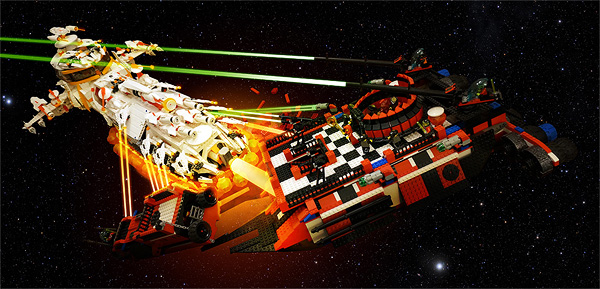
| The Allied Nations / United Systems warship Ripper acts as a delivery platform for an Orange Transparent Chainsaw the size of a battleship. The Akkadian flagship S.S. Dethstar is less than pleased to accept delivery. |
Photo: Stubby
From "Rainbow War II: Jellybean Apocalypse: Grail War, Turn 1"
Elements shown:
LEGO |
|
The best thing about big Creations is smashing them into other Creations. For many budding plastic-brick fans, smashing stuff into other stuff is the first game they play with their brick constructions, and for some it's all the game they'll ever need. BrikWars salutes the Human spirit and its fundamental drive to smash.
Limited versions of the rules for handling Collisions have been presented twice before, for two specific object Sizes. The rules given for minifigs (5.4: Charge!) are the rules for objects of Size 1", while the rules given for Horses (H.3: Fighting From Horseback) are the rules for objects of Size 2". The rules presented here are the generalized rules for objects of any Sizes running into one another, whether deliberately or otherwise.
Momentum
Momentum = 1 MOM per 4" of straight-line movement, up to a Charging Creation's Effective Size
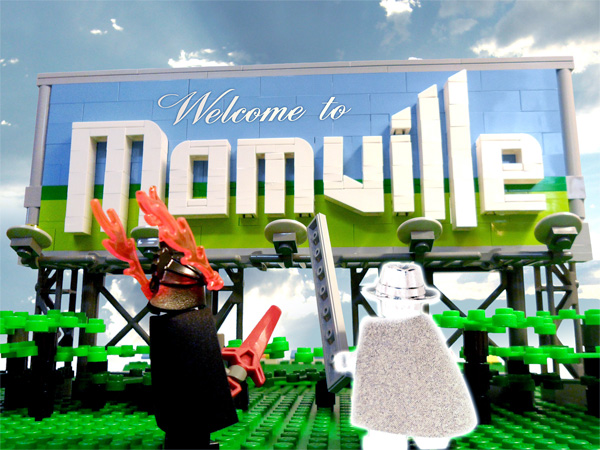
| Knowing of Warhead's uncontrollable mom-lust, the mysterious entity known as FedoraNuker creates an afterlife paradise for the souls of all hot moms. The ensuing momicide is the first step in a convoluted scheme to break Warhead down using the dark and forbidden art of Psychotherapy. |
| Forum Thread: The Unmortal |
|
Collisions become much more satisfying as the colliding objects get bigger, but they also become more complicated. Where a Size 1" minifig can build up a Momentum of 1 MOM with a Charge of four inches (5.4: Charge!), and a Size 2" Horse can gather 2 MOMs in a Charge of eight inches (H.3: Fighting From Horseback), a larger Creation is able to build up a correspondingly larger pile of MOMs as it extends its Charge over a larger number of inches.
In order to build up its MOMs, a Creation must Charge in a straight line. The Charge follows the same rules as a Sprint: the path of the Charge may go up or down sloping terrain or over gaps and obstacles if they're small enough for the Creation leap over without slowing down, but if the Charge pauses, slows, or turns to the left or right, then all Momentum is cancelled and the Creation will have to start over collecting MOMs from scratch.
For every four inches in its continuous Charge, a Creation gains one MOM, up to a number of MOMs equal to its own Size (or Effective Size, if it's taken Size Damage (7.2: Taking Damage)).
Large Creations may not have enough Move to build up to their full Momentum in a single turn. Creations can extend a Charge over multiple turns to travel the distance required. These Extended Charges are best used against inanimate targets like walls and security gates, since a more mobile target can casually walk off of the line of a Charge between turns and sidestep the attack entirely.
In the case of an Unintentional Charge, such as for Out-of-Control Vehicles, minifigs running into invisible walls, or objects falling from great heights, players may not have been keeping track of an object's Momentum. In cases like these, it's up to the players to determine the Charge distances after the fact by estimating how much straight-line distance the objects traveled. Only the turn immediately prior to the impact need be considered; objects don't unintentionally make Extended Charges. (However, players should be generous in overlooking slight curves in the path of an Unintentional Charge, since Unintentional Damage is much funnier than the regular kind.) As a rule, all of a falling object's travel is counted as being in a straight line; players are expected to forget they know anything about parabolas for the purpose of maximizing Damage from falls.
Spending MOMs
While Charging Creations can potentially have a much larger pile of MOMs than minifigs and Horses, they spend them in much the same ways. MOMs can be used for boosting extreme vehicular maneuvers or catapult launches, but they are most often used to add Damage to a Charging Weapon attack (up to a limit of one MOM per inch of Charging Weapon Size) or KnockBack to a Collision. A MOM disappears as it is spent, but the object can earn its MOMs back again by continuing to Charge in further four-inch increments, even during the same turn.
Crashes and KnockBack
Collisions are an immediate and reliable outlet for aggression. They require no Attack Roll, automatically succeeding unless the target manages to Bail out of the way (4.3: Enemy Response).
However, they can be equally dangerous to collider and collidee alike. Each object in a Collision does Crash Damage to the other - as many d6es of Damage as either its own Structure Level, or the total number of MOMs in the Collision (including the target's, if the target is Charging towards the colliding object at the same time), whichever is fewer.
After Crash Damage has been resolved, the Colliding object delivers 1d6 worth of KnockBack inches to the target for each of its MOMs. The defending object resists the KnockBack with its natural Physical Opposition, with one POP d6 for every inch in its Effective Size.
| Objects that are nailed down are only Knocked Back if they were broken by the Crash Damage from the collision. If not, all the MOMs are lost without further effect. |
If the defending object successfully resists the KnockBack, the Colliding object is stopped and loses all Momentum. Otherwise, the Colliding object loses as many MOM d6es as the target object had POP d6es, and can keep right on Charging with its remaining MOMs.
| Crash Example: Don Coyote and the Fire Giant |
Example: The biker Don Coyote (Skill: d6) tilts his lance
at a rampaging Fire Giant. His motorcycle gives him
a Size rating of 2, so Don Coyote guns the engines along
the necessary eight inches to build up his full 2 MOMs of Momentum.
The Giant has a Size rating of 4 and is wearing Armor Plated shin guards, so he's not very worried. Rather than trying to dodge, he decides to allow the Joust in order to bring Don Coyote close enough to engage in Close Combat.
The lance is a Size 2" Charging Weapon, so Don Coyote will be able to spend both MOMs to add Damage if the attack is successful, raising the Damage from 2d6 to 4d6 against the giant's shin guard.
Unfortunately, Don Coyote fails the Attack Roll and misses with the lance. He must continue Charging forward to the limit of his Move inches, causing him to crash directly into the Giant with the motorcycle. He wasn't able to spend his two MOMs in the missed Joust atttack, so they now become 2d6" of KnockBack instead. He rolls 8".
The Giant has a Size of 4", and so he has 4 POPs to resist the KnockBack. The Giant rolls 13", easily resisting Don Coyote's KnockBack of 8". The motorcycle is stopped in its tracks.
The motorcycle has a Structure Level of 1, allowing it to deliver one die of Crash Damage. The 1d6 Crash Damage is negated by the Deflection of the shin guard, leaving the Giant unharmed. Although the Armor Plating gives his leg a Deflection bonus, the Giant's "natural" Structure Level is only 1/2, limiting his own ability to deal Crash Damage to zero dice. He does no Damage at all in the Collision.
With no effect from either the KnockBack or the Crash Damage, Don Coyote is brought to a halt and trapped in Close Combat with the Fire Giant. The Giant Counterattacks with a mighty football punt. |
|
| Falling Damage |
Falling Damage is treated as a standard Collision between a falling object and the ground. This doesn't generally end in success for the falling object, since the ground has a Size rating of over nine thousand, making its potential Physical Opposition almost limitless.
Generic surfaces can be divided into soft and hard ground according to color. Green (grass), brown (soil), or tan (sand) ground is considered comparatively soft with Structure Level 1, and so never does more than one d6 of Crash Damage. Gray (stone) or black (asphalt) ground is considered much harder, with Structure Level 3, meaning it can do up to 3d6 of Crash Damage if an object falls far enough to build up the necessary Momentum.
If the falling object's damage manages to exceed the ground's Armor rating (1d10 for soft ground, 3d10 for hard ground), players may elect to build a crater ring around the impact site, with bricks of height and inches of diameter equal to the number of dice in the falling object's Momentum.
It's a generally accepted action-movie fact that pools of liquid such as water or quicksand, no matter how shallow, will cushion Crash impacts safely and completely. Of course, if the liquid is something like stomach acid or hot magma, it may subsequently do other types of damage on its own. |
If a target is Knocked Back far enough to land on its side or upside-down, the object is Knocked Over and Disrupted, unable to take any Action or defend itself until it gets itself back upright. For vehicles, it's even worse: while a Knocked Over delivery truck is largely helpless, Knocked Over boats
are capsized and sink at the end of their following turn; flying vehicles
tend to crash.
If the Charging object is larger than its Disrupted victim, it may proceed to run right over it, inflicting points of Trample Damage for every inch by which its Effective Size exceeds that of its victim. Smash and Trample Damage are cumulative with any other Damage dealt in the course of the Collision.
|
|